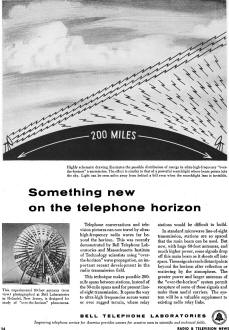Bell Telephone Laboratories - Over-the-Horizon Communications |
||||||
Over-the-Horizon (OTH) radio signal transmission was a relatively new phenomenon when this advertisement by Bell Telephone Laboratories appeared in a 1955 issue of Radio & Television News magazine. It was a big year for OTH. The discovery and exploitation of it was originally the domain of Ham radio operators who were allocated the believed-to-be useless spectrum that supports it. However, once the government realized the important ramifications of OTH communications (radar, voice, video), military research organizations quickly initiated efforts to exploit it for national defense and security purposes, then classified much of the science. In this same year as this advertisement an article by Bell Labs about OTH technology entitled, "'Over the Horizon'" Transmission" appeared in Popular Electronics magazine, saying how previously it was thought the only practical means of transmitting by radio the wide bandwidth needed for television and multichannel telephone service was line-of-sight (LOS). "This was disproved after years of research at M. I. T. and Bell Telephone Laboratories. The Bell Laboratories' research stemmed from Bell's success with transcontinental microwave systems for carrying telephone conversations, radio and television programs from coast to coast, and their continued interest in radio propagation. The M. I. T. interest was stimulated by work for the Government in radar and overseas broadcasting." Bell Telephone Laboratories Ad
Something new on the telephone horizon Telephone conversations and television pictures can now travel by ultra-high-frequency radio waves far beyond the horizon. This was recently demonstrated by Bell Telephone Laboratories and Massachusetts Institute of Technology scientists using "over-the-horizon" wave propagation, an important recent development in the radio transmission field. This technique makes possible 200-mile spans between stations, instead of the 30-mile spans used for present line-of-sight transmission. It opens the way to ultra-high frequencies across water or over rugged terrain, where relay stations would be difficult to build. In standard microwave line-of-sight transmission, stations are so spaced that the main beam can be used. But now, with huge 60-foot antennas, and much higher power, some signals drop off this main beam as it shoots off into space. These signals reach distant points beyond the horizon after reflection or scattering by the atmosphere. The greater power and larger antennas of the "over-the-horizon" system permit recapture of some of these signals and make them useful carriers. The system will be a valuable supplement to existing radio relay links. This experimental 60-foot antenna (rear view) photographed at Bell Laboratories in Holmdel, New Jersey, is designed for study of "over-the-horizon" phenomena. Bell Telephone Laboratories Improving telephone service for America provides careers for creative men in scientific and technical fields.
Posted November 16, 2020
|
||||||

